Cillie Rentmeister – The Finland Lectures – held at Helsinki, Sibelius-Akatemia, March 5, 1985 and at Jyväskylä University, musiikin laitos / Music Institute, March 14, 1985

Headline: “Will Cillie bring feminist Rock to Finland?” Iltalehti, Helsinki, March 6, 1985
Note: When reading this article please keep in mind that it is the original text from 1985 – it reflects the subject from a perspective just ten years after it had all begun…
It’s Not about Rock Ladies…. Introduction
Maybe, you have heard these voices and sounds – of Nina Hagen, Nena, Inga Rumpf?
This is not going to be a lecture on actual German Rock ladies and female pop stars. This is also not going to be a scholarly discourse.
Instead, I wish to invite you on a journey through the last ten years of all-women Rock bands in Germany, and to listen to the sounds (which express and reflect the development, the rhythms, the emotions and the vibrations) of the women’s movement.
In 1974, I was cofounder of the first women’s Rock band (the FLYING LESBIANS), in Germany, in West Berlin – and I am still making music today. Thus, I will be looking back from my very personal point of view. You might well consider our journey as an ethnological trip to a strange world: with strange customs, strange rituals, strange words – to Amazonians and women’s counter cultures; and I am your native informant.
However, you will soon notice that many of the sounds of women’s music do not sound strange to your ears at all. Even the most separatist women’s counter-cultures do not exist on totally isolated islands; the shores of these islands and the ears of the women are filled daily with the sounds and noises of real oceans of male, manmade Rock music, with all its waves and mainstreams – with “their masters’ voices.”
When women choose to play Rock music (in its widest sense), they have chosen a form of music that is defined and performed almost entirely by men. Within the women’s music movement, this fact led to the objection that women should not play Rock music at all, because one cannot take a macho music form like Rock and give it a new feminist function – or to use the Biblical metaphor, “Nor do people put new wine into old wineskins”.
Meri Franco Lao criticized the procedure of adaptation as “Travestie.” She said: “As a women, you must make totally different music; you must not use any instrument from the patriarchal orchestras or built by a patriarch; you must not use their musical forms. You must not perform their rituals. You shall play witches music and reconstruct and recreate their musical forms.”
Thus, one of our main questions is: Have women in Rock music achieved a specific identity? Have they developed special qualities – which we could call parts of a real women’s counter-culture? Could they express the emotions, rhythms and feelings of the women’s movement?
Please keep in mind that the following music examples are taken from records, and that the sterile studio atmosphere sometimes cut off the very special live qualities of these bands. It’s never only the sound that makes the music and its resonance. Please imagine that it was played at women’s festivals, large-scale women’s parties and concerts, with their special atmosphere, rituals, happenings and activist contexts; and with a live eroticism, which was sometimes in the air. We cannot revive all this here. Besides, I can only introduce you to those few, happy women’s bands who were able to produce records at all.
We will look at the development of the last ten years in three chapters, because I perceive three phases and three generations:
1. In the 1st chapter, I will introduce you to the first generation of all-women Rock bands; the “euphoric phase,” inseparably connected to the euphoric state of the West German Women’s Movement.
2. The 2nd chapter deals with the years following 1980, the era of Punk and New Wave, which gave an impetus and encouragement to the rise of new scenes and groups of women, who wanted to build up women’s bands. This is also an era of much more variety, but also of commercialization.
3. The 3rd chapter deals with the current situation – a phase of orientation, contrast, hope and despair, boredom (ennui, noia) and helplessness, of the end of any avantgarde; a time of tensions and suspense between the poles of African drums and music made on computers… A time of waiting and learning. Learning what?
1. First Amazonian Generation, “Euphoric Phase”
It all started overnight with the first German women’s Rock band, the FLYING LESBIANS, in the year 1974 in Berlin. The first large-scale women’s party was staged to celebrate, following the first 5-8 years of the women’s movement there.
A tv documentary about an abortion that caused a scandal (it was cut from the station’s scheduled programming) was to be shown at this party; a huge university hall was rented by a group of women and a live band was required. A telephone chain was initiated to put a band together. In the end, there were sixof us. One woman had already played bass in a male band, another had learned some drumbeats from a friend, and for half a year I had been trying in vain to form a women’s band, but was frustrated by many technical and personal obstacles.
Our future band met for the first time the day before this women’s party started. Male bands lent us instruments and amplifiers and had them installed in the hall.
Some of us put our own original songs and texts out on the table. It was not too difficult to agree that we would play mainly Blues and Rock patterns, and we would just spread our texts over these patterns. It worked. We were welcomed by a wave of enthusiasm from the two thousand women who had come to the party; and this same wave carried us through both some off-beat music (“schräge Töne”) and some cliffs for the next three years that we existed as a band.
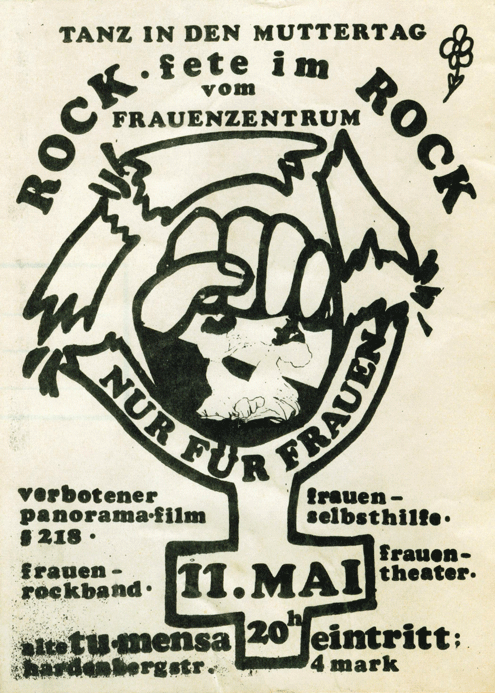
This was the “fresh” state of the women’s movement. Thus, our “HALF OF THE HEAVEN” and later “FLYING LESBIANS” band started as a live appearance and party band, and maintained this character for the three years of its existence.
Of course, our band was born in an atmosphere and a time that were very favorable and ripe. Before then, in the 1960s, Rock music, “oh baby baby,” was definitely a man’s world. Still, there had already been a few so-called “all-girl bands.” Two of them were especially present in our record collection – as WOMEN in Rock, they were a type of role model for us. We thought they were exciting! [Music from: Fanny and Liverbirds]
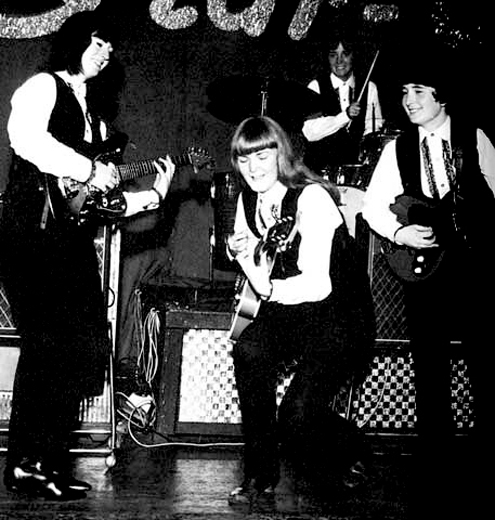
Liverbirds

Fanny
Did you recognize them?
The “Liverbirds” and “Fanny.” In 1963, John Lennon said to one of the Liverbirds: “An all girl band? Go on and try – but it will never work!” But it did work! Ten years later, the atmosphere was more favorable for us.
The student’s and the women’s movement had prepared the field. The “non-dogmatic” and anarchistic Berlin scene generated its own cult band, which gave us drive and inspiration – and supported us technically: TON- STEINE – SCHERBEN (TSS, in English: “Sound – Stone – Pieces”).
TSS were the first very successful, non-commercial Rock band, who connected a new, emancipatory and revolutionary group lifestyle to their music. They started to produce and distribute their own records without any media giant to back them – were “indies” before the era of Punk. AND they sang their messages of and for the non-dogmatic movement (“Spontis”) in German, – not in English – which was also quite revolutionary. Many young people sang their songs by heart.
They created political slogans for the movement: “No power for nobody!” or “Destroy what destroys you!”

1.2 FLYING LESBIANS – Mission, Vision, Values
Thus, in 1974, with a little (respectively, quite a lot of) help from male friends such as TSS, we were initiated into the mysteries of electro-technics, including amplifiers, small mixers, PA’s and boxes, and instruments.
Our mission, vision and values were mostly taken from the women’s movement to which we belonged.
What we didn’t want:
. We rejected the “Gigantomania” of the Rock business of the early 1970s. The colossal, gigantic power towers of amplifiers and boxes. For us, concerts with a volume up to 120 dB seemed like “raping” the public.
. We rejected those macho gestures of men, who used their instruments like sexual organs and who performed a concert like a violent sexual act and as a submission ritual: “Under my thumb…” sang the Rolling Stones.
. We disliked the egotrippers, sex maniacs with their groupie system, their fantasies of almightiness, and how they let the puppets dance. We disliked the enfant terrible attitude, and how they let their roadies work – real slave work!
. We were fed up by super solists like McLaughlin (even while admiring the artistic perfection of Santana), who used their fans and their public for their showmanship. In this respect, we defined the Rock business as “social deficitary.”
This was basically summed up our opinion of men in the Rock business.
(Were the Rock ladies better? They usually were featured as “front-line sex objects.” Even if Tina Turner was rightly called “the first sex-subject” in Rock music, she also once said: “If my ass is gonna make them pay attention to my voice, you got it.”)
As for positive action, we wanted:
. to be amateurs instead of professionals. We wanted less distance to the public. We wanted the other women to say: “Hey, we could do that, too!” To be self-critical: Of course, none of us could ever have become John McLaughlin. But we should also keep in mind that girls seldom start with electric guitars, or with drums as early as boys – whereas boys often begin at age eight, ten or thirteen. The situation remains the same today.
. We wanted to play “our OWN music and songs.” We never played “good enough,” to cover the songs of other famous groups (other, male groups often begin by covering the music of their idols, but sometimes they do it for years, with the risk of not coming up from their cellars, because they fear that they are not yet good enough…)
Even if the ideas of “our own music” turned out to be partly an illusion, we wanted to do our own thing, and we did not want to be measured with respect to famous male groups. This was also an illusion, because we had their technical and professional standards in our own minds and ears.
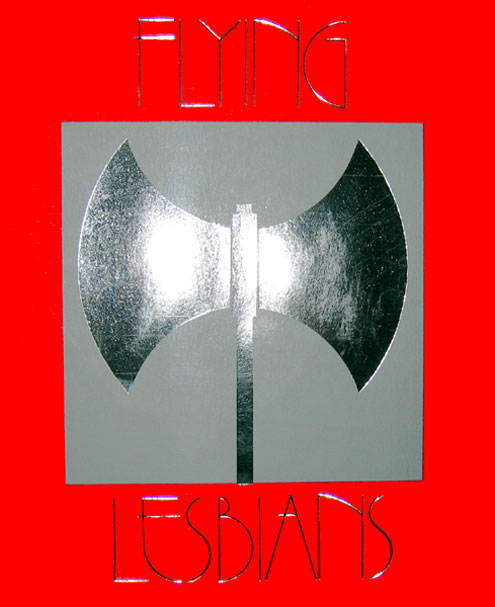
It was though the lyrics that we came closer to our aims. We identified with the “big issues” of the lesbian’s and women’s movement’s, expressing them in our lyrics, turning the movement’s slogans into songs – and mirroring it’s euphoric, rebellious, Amazonian and optimistic mood in those early years.
Most of our songs had melodies, so that women could sing them along with us. Some were quiet, some with a “full orchestra.” We were singing about battered wives, love (between women), about disappointments caused by women in power, on bisexuality which was “in” at that time, on girl junkies and female unemployment, and about matriarchy – “we are one million years old, but what did we learn?”… We sang songs of anger, and songs of love.
In 1977, Miriam Frank wrote:
“Flying Lesbians is wonderful German, women-made music… The Flying Lesbians are the German women’s movement expressed in music. Each song reflects an important idea, criticism or problem that is being worked out now in the project collectives and women’s centers of West Germany, or that is being argued about in women’s Kneipes (bars) and around communal tables. The record is alive…not only because it is popularly distributed and widely played, but also because it succesfully synthesizes ideas and action through music – Rock music…
The blatantly lesbians songs by the Flying Lesbians are surely different from the cozy sweetness of the last few years in American Lesbian music. They’re refreshingly aggressive and controversial. The first song, “I’m a Lesbian, How About You” is a tight boogy woogy, very danceable, with especially nice piano and guitar work. It’s a lot of fun, and then come the two hard ones…
The Flying Lesbians really take off with “Frauen kommt her.” This song, “Women, come on, let’s get it together, united we are strong” (transl.) has been sung in the women’s movement for years now, in small groups, at demonstrations, in ever-widening circles, and the Rock setting gives the song a special richness, openness and happiness. It’s the showpiece of the record…”
(Miriam Frank, “Off our Backs” magazine, Sept. 1977, p. 15.)
1.3 Women’s Parties, Women’s Festivals – Initiatory Ritual and “Gesamtkunstwerk” (total art work)
We shared the ideas of basic democracy in the women’s movement, of spontaneous and egalitarian collectivity. In our texts, we often used the “we”: WE women get together, because only together WE are strong! That became the following: “Frauen kommt her, wir tun uns zusammen…”
Instead of musical perfection, we defined our “quality” as a band on a number of factors. For us, music was primarily a social event, an experience of solidarity, sisterhood and love among women, who had been separated from one another for so many centuries. We were nearly exclusively playing at women’s parties. Often these parties highlighted events and actions – demonstrations, conventions, summer universities. Or some money was simply needed for a women’s center or a project – these festivals normally generated remarkable profits, because the organizers and groups worked as volunteers.
The parties themselves combined politics, music, show and emotion. They were a complex happening: Movies concerning women’s issues were shown; women’s health groups demonstrated new methods of gynaecological “self-examinations;” women showed “self-defense” dances and Karate Katas; speeches were held; huge buffets were built up with self-prepared food; the women had their fill of wine, beer and liquor; and women who would never have taken a step into a women’s center entered these parties to throw a cautious first glance at these wild, young “women’s libbers.”
There is still another major point why women parties, often with thousands of women, were such an important “initiation ritual”: They were also the settings for the coming out of lesbians – and we gave a musical voice to this happening.
We very consciously chose our provocative name “Flying Lesbians.” We were not alone – everybody had to take a stand. Would women’s groups, who organized concerts and festivals – would they print this name on the poster? Radio and disc jockeys: Do they have difficulties mentioning our name, playing our music, or giving us interviews?
This open lesbian attitude came out of the feminist political context, where we used provocation and disclosure as a means of gaining attention and to reach our aims. (Over the last decade, musicians have talked more frankly about widespread homo- and bisexuality in the artist’s scene and within their own experiences – like Bronski Beat, Frankie goes to Hollywood, Joan Armatrading and Gianna Nannini… Nina Hagen discussed her bisexuality in interviews; Patti Smith lives with a man, but says that all her sexual and erotic fantasies deal only with women’s love.)
We wanted equal rights and equal attention for each member of the group: No lead guitarist, no single lead singer out in front. That’s one reason why four of the six of us sang.
We wanted to do everything by ourselves, to learn everything. On concert tours, we wanted to drive the trucks by ourselves and to install the equipment without male (or female) roadies. Therefore we had to have small scale equipment, which we could carry. We played more than forty times and did quite a lot of tours through Germany and other European countries – so you can imagine that we got muscles and skills in all the wrong places – in the arms, instead of the fingers, for those who had to play. Sometimes, we even fetched the beer for the party with our truck. Sometimes, we were exhausted by the time we started to play in the late evening.
There was hardly any distance between us and the public if at all. We did not retreat before a concert started (sometimes a mistake). We were out in the hall and fully took part in the event. Before starting to play, we often had to search and round up our band members by microphone. Not infrequently, women came to me and made arrangements for lectures at their universities, or we discussed the proceedings of feminist studies in art and art history….
You see, we wanted all and everything, we wanted the “Gesamtkunstwerk,” the overall art-and-life event. The women’s parties of the Amazonians, the euphoric first years, were an attempt to realize such utopias.
Monique Wittig and Sande Zeig called us wanderers:
“FLYING LESBIANS. Tribe of companion lovers who, as their name indicates, are wanderers. The Flying Lesbians come from Germany and have companion lovers everywhere. Singers and musicians, they owe their celebrity to the fact that they were the first group of wandering lesbians in the raving that began the Glorious Age.”
(Monique Wittig and Sande Zeig: Lesbian Peoples. Material for a Dictionary. New York 1979)
1.4 The time afterward
The FLYING LESBIANS played for three years. They stopped playing when they found that the ideas and the development as a group had stagnated. The members had undergone different personal, political and musical developments. Some wanted to spend more time with music, some less. As for us, the euphoric wave of the women´s movement, which had carried our band, wore off. The surprise factor, the flair and the sensation of the first years, and women’s parties turned into routine for us. In a 1977 “farewell letter” to the German women’s centers, groups and projects, we wrote:
“We, the Flying Lesbians, need a creative break…The numerous live appearances have left their marks behind. Slowly, we’re beginning to feel more like a ‘mobile action orchestra’ than as women who use musical contributions to take part in a celebration of women.
It just isn’t always possible to go to so many parties one after another, always with the same form of appearances, always with new women, that one can hardly get to know it all without falling into a certain routine.
We accomplish a task, but nevertheless stand a bit apart, because for us it is becoming less and less spontaneous. Perhaps we are becoming more secure with the pieces that we play again and again, but soon we won’t even be able to listen to them any more.
The enormous time expended in the many live appearances has overtaxed us, because we all work or study and devote ourselves to the band in our free time. We no longer manage to advance ourselves musically, to create new pieces or new texts. We have the feeling, we are standing still and this has affected our group dynamics…
Consequently, through our decision, we intend to create a productive vacuum for ourselves and for the other women’s bands, who already exist.”
Within this letter, typical for our democratic values, we meticulously documented our state of finances (at the time a sum of some ten thousand German Marks) – among other things our expenses and receipts that were concerned with LP productions.
As we said in this farewell letter, in an “organic” manner in the West Berlin scene, one woman’s Rock band grew out of the other, as if out of mother corn. From the FLYING LESBIANS, some members founded “Johanna Revolta” (an allusion to John Travolta); from 1977 on, “LYSISTRARA” came into scene life. In the early 1980s, “LES-BE-TON” were formed from Johanna Revolta and Flying Lesbians. I was a member of LES-BE-TON, but this was already the early 1980s and therefore belongs to the “2nd chapter.”
Let’s listen to LYSISTRARA, who produced an LP in 1979. Note the difference. Instead of the “we,” they often speak very personally in the first person: “I cannot hear it anymore,” “I want to emigrate.” Their music was more sophisticated and they also played violin and flute – instruments, which we in the time before, thought to be very unRock-like and too “female,” because these were the instruments, a girl usually was forced to learn. The arrangements were more complicated, with an effect, in my opinion, that it required more of the attitude of a listener from the audience, as if in a concert; it was less a music for dancing. Let’s listen.


Another women’s music group, called SCHNEEWITTCHEN, was very successful and produced two records.
For some, they represented “the real female music.” They were technically very good, as you will soon hear. They produced a kind of folk music, not only in respect to their compositions and instrumentations, but also in their texts: They took traditional German folk songs and filed them up with new, feminist content. “SCHNEEWITTCHEN” (Snow White) herself, as you might know, is the main figure of a German fairy tale. They chose this name as a program, but in a different sense than that of the fairy tale story. Schneewittchen was bewitched; she lay as if dead in a coffin of glass – and she was only brought back to life when the prince came and kissed her.The band SCHNEEWITTCHEN said: “All women are kept like Schneewittchen, waiting for their redeeming prince, but all we Schneewittchens would be better off breaking and smashing our coffins of glass; our more or less golden cages.”One song was really successful. It is still sung today by the “next two generations” of the women’s movement: “Unter dem Pflaster, da ist der Strand. Komm, reiß auch Du ein paar Steine aus dem Sand” (“Under the pavement, there is the beach. Come on, grab some of the stones out of the sand.”). It is a song that oscillates between severity and softness.

2. The 2nd Generation – Punk, New Wave and Ingenious Dilettantes
While LYSISTRARA and SCHNEEWITTCHEN were playing their soft songs, a second generation was already rehearsing in their cellars for their coming out.
Since the beginning of the 1980s, Punk and New Wave spread over Europe, and expressed this generation’s attitude toward life – a dark present and no future. Whereas New Wave took it with nonchalance, coolness and sometimes irony, Punk reflected destructivity and attacked ruined humanity under the bourgeois cover of order and discipline. There was great fear of war, because the United States and the USSR deployed middle range missiles in Germany.
Punk and New Wave opened the doors for many newcomers into the world of music. They couldn’t give a shit about professional accomplishments. Everybody could go on stage and make music. And many did – anarchic, professional bluffers, ingenious dilettantes, talented musicians, freaks and fans of a new simplicity and directness.
Many women went on the stages without having any connections to the concurrent women’s movement. In contrast, they often wanted to have nothing to do with it.
A male critic once commented on this era: “Whilst the first generation of women Rock musicians is still complaining and demanding, the second generation just and simply makes music.” It’s not quite so simple, I would say. At least the field for all-women’s groups was prepared; people had become used to the idea of women in Rock music, with electric instruments and much amplified power.
Unlike the first generation, they headed for commercialization, even posing “punk” protest, as you know. There were not many scruples. In fact, just the opposite. Hopes and aspirations for a commercial and professional career and for social advancement were an important impetus for this music.
2.1 The “Venus Weltklang Festival” – “From Women for Humans”
I’ll play some music examples from a highlight event of this second generation: The “Venus Weltklang Festival” in Berlin 1981.
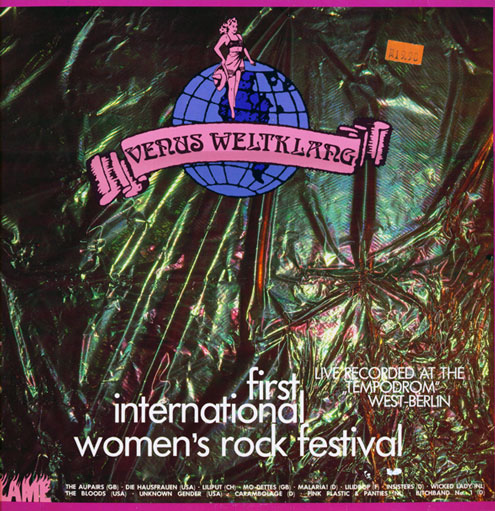
What’s the matter? The song’s messages did not play an important part there. The texts of the German women’s bands sound very problem-orientated, heavy, humorless, depressive, sometimes militaristic. Black is the favorite color for clothes. The aims of this music said: Let aggressions out! Provoke feminists! Or “BITCHBAND,” for example. They liked to provoke feminists by looking very militaristic, and letting a naked women dance on stage as a kind of Go-Go-Girl while they were playing.
We also find fashionably styled bourgeois destructivity and “Weltschmerz” (world-weariness); a sense of catastrophe. Note that even the names of these bands have a “program”: MALARIA, STRAPAZE, BITCHBAND, CARAMBOLAGE. They all spread a “hautgoût” (gourmet taste) of disaster, illness or stress.
Please also note that “Venus Weltklang” was a highly commercialized festival. Musicians of the less famous bands complained afterwards that they had no time at all for sound checks, while Gianna Nannini, the superstar with her all-male band, got one hour; and the whole program was rearranged just a few minutes before the concerts started to suit television needs.
If television had not financed the spectacle the festival would have been a financial flop. Instead of the 2000 people expected, only about 1200 came each of the three evenings.
The festival’s subtitle “Von Frauen für Menschen” (“From Women for Humans”) could be read as affront against the feminist bands, who explicitly played “for women only.” It was as if the organizers wanted to say: “For such emancipated women who have already lived and had parties together with men.”
However, although those bands doubled their audience (so to speak) by including men, the commercial success of these women’s bands remained below average.
Let’s listen to the music of these women’s bands from 1981, of the second generation: to “Bitchband” and “Malaria”.
At the Venus Weltklang Festival, some softer groups also played, who had also retained (or regained) a tendency toward feminist and women-specific subjects in their texts. As an example, I’ll play the “Insisters”. They combine a political and (heterosexual) emancipatory claim to a quite professional music, with popular arrangements that also include reggae and funky elements (politically, they seemed connected to a quite orthodox left milieu with an affinity to West Berlin’s “Socialists” of the SEW party).
2.2. Where have all the Feminist Musicians Gone?
Ina Deter is an example of a singer/songwriter coming from grass roots feminism making her way quite successfully to commercialism – in 1974 with a song like “I have aborted.”She became famous for her song “I spray it to each wall: this country needs new men…”
But what were the other feminist musicians doing during this second phase – the amateurs? The women’s movement had settled down in many projects all over the country. The former students had become professors, teachers, social workers, nurses, journalists, physicians, lawyers, filmmakers, craftspeople and tradeswomen. It was a phase of consolidation. We experienced a professionalization of the women’s movement and projects, as well as a growing dissemination of feminist ideas – e.g. feminist women’s magazines like Courage and Emma (since 1977) which gave women’s concerns their own voice, and “Gleichstellungsbeauftragte”/ “Frauenbeauftragte” (women’s representatives; since 1981) spread these ideas into politics.
Many feminist women were engaged in the movements of the Greens, Alternatives, Squatterers and the Peace Movement. This channeled a lot of energy and the fear of nuclear war in Europe particularly overshadowed feminist issues.
A new interest arose for spiritual matters and the ancient wisdom of the Far East, and occasionally for magic practices.
The very strict separatism of feminist doctrines softened up. Because it was still hard to find other qualified women musicians, amateurs or semi-professionals including some feminists and lesbians started to play with men or in mixed groups. Then another quantum leap occurred, when feminist bands like LES-BE-TON and AUSSERHALB now sometimes played for a “mixed” audience – first for homosexual events, then for alternative and political events.
3. The Third Phase: Present Trends – Complex and Contradictory
Yes, we find some prominent women making Rock and Pop music in the current international music scene: Rock ladies from Nina Hagen to Pat Benatar; popstars like Nena; avantgarde cult personalities like Laurie Anderson.
Additionally, we find more and more professional female band members, including Tina Weymouth of the TALKING HEADS and the women of the JOE JACKSON Band. We find more and more women as studio musicians and women as successful producers and promoters, such as the Humpe sisters. In Synthie Pop there are solo players like Cosa Rosa and Miko Miko.
Nevertheless, at the moment (in 1985), it seems to me as if the international music scene is facing a period of stagnation, of reviving the styles of the 1950s and 1960s. Bored by a flood of synthetic sounds, some musicians have grasped their old-fashioned acoustic guitars once again. Others stop making music – others stop making sense.
In Germany, Punk and the “Neue Deutsche Welle” phased out around 1983-84. The music industry stopped releasing singles, which were an important media, because they were relatively cheap –especially for newcomers to test new ideas – and for women’s bands. The compact disc appeared on the horizon, but is actually an expensive product.
There also seems to be a kind of pause inside the German feminist and women’s movement – a vacuum – a certain waiting for something new and for inspiring ideas; perhaps a crisis. Not in a negative sense, but in the sense that women who are interested or experienced in music try to go new ways, according to their personal – maybe therapeutic – needs, and to their political beliefs and lifestyles.
I will briefly describe two of the paths that women from the feminist scene are currently exploring.
3.1 “E.M.P.” – My Electronic Way
In 1983, I started a solo project called “E.M.P.” and released a single LP under the same name.


The three letters originally meant Electro Magnetic Pulse, which is a side-effect after the explosion of an atomic bomb. Not only heat and radioactivity and blast waves spring up at that moment, but also large electromagnetic fields, which paralyze (like lightning) all electronic equipment – both the military equipment in the war command centers as well as my synthesizers.
You might also translate these three letters as:
End of Manmade Power – Even More Pacifism – Eternal Male Punctures – Eat Magic Pills – Electro Magnetic Patriarchy – Experience My Plagiarism…
At the moment it seems to me that I am the only woman in the German feminist scene who is interested in and playing with synthesizers, rhythm computers and sequenzers. It is well known that many women have no great faible for computers. They find them stupid and they don’t want to submit to their supposedly stereotypical, non-spontaneous rules.
I call computers “Junggesellenmaschinen” (“Bachelors machines”). It is true that computers can make one lonesome, sometimes solipsistic; and their users have already created a new type of woman in the industrialized world – the computer widow, mostly leading to divorce. It is also true that computers in music have made some musicians jobless.
On the other hand, after so many years of socialization in bands, I am enjoying the concentration, the possibility to look and to listen to what is hidden in me, and to try to unfold and realize that.
I am fascinated by these toys, because they force one to connect to different means of creativity. To connect to the left side of the brain, the composer’s half – to rational, analytic thinking, to understand and use the electro-technics; and to the right side of the brain, the emotions and intuitions, the feelings, the musician’s side.
One could argue that the connection of the two hemispheres of the brain is the basis of all creativity, at least in the Western world since the Renaissance, as well as the origin of “mental” music. That is true, too. But music computers are demanding in an additional way, because one should also understand something of the world of the physics, of sounds and waves.
Women probably seldomly use synthesizers, because they cost a lot of money – and women are the poorer half of mankind. Male musicians use insanely large synthesizer systems, such as the Fairlight computer (for $30,000 US), used by Tangerine Dream, or Spliff. One could ask whether the quality of music has become better through the means of gigantic technical possibilities and effects? Or whether the audience will not soon become oversaturated with automated effects? We will have to wait and see.
I especially like sequencers, because of their meditative or trance qualities. One can use them well for a style of Minimal music. However, what I have recorded up until now belongs more to the Pop genre. I call it “schrägen Pop” (which means oblique or unusual).
I’ll play a clip of one song for you called “Deadly Force.” I had the idea for this song when giving radio interviews in a German area, where Pershings were going to be stationed. I visited some of the already existing missile camps. I also visited a concentration camp, which had been used in this area. I was shocked by the structural atmospheric similiarity between the military camps and the concentration camps: broad streets leading directly into the sites and railway tracks; high fences; rows of floodlights; big signs saying “Deadly Force authorized – Restricted area.” “Achtung, Schußwaffengebrauch.”
I interviewed people on the streets on how they feel about the stationing of the nuclear weapons close to their village. Some cited a well-known German proverb: “Was ich nicht weiß, macht mich nicht heiß” (“I don’t think about it. What I don’t know, won’t rile me up.”). And I thought to myself that only some forty years ago, they could have said this same phrase to themselves.
I sampled an original voice from these interviews and mixed it together with my music. It sounds like that: “Deadly Force Authorized…”
[Remark CR 2007: You can find reviews and Mp3 files of E.M.P. at www.sphinxmedien.de]
3.2 Mobile Music – by and for Women of Action
Another trend that has actually been influencing feminist “moved women” for two or three years is the current interest in African and South American music. African drums do not seem so worn out; African musicians not so exhausted. In contrast to our fashion of coolness, they seem hot and alive. Many people are tired of harmonies and melodies. They want rhythm and to go back to the roots of music. Some people use it for therapeutic reasons.
At the same time, since about 1983, another “New Wave” started – of political actions, such as large demonstrations, blockades and anti-missile camps. Again, these required a type of mobile and live music. That meant two trends. First, the creation of new songs; second the creation of mobile bands or music groups who could easily carry their instruments with them (I unfortunately have no tapes of Greenham Common!).
This was the moment, when the squatter scene, the Alternatives and the Green Party, the Peace Movement and the women’s movement detected SAMBA.
The drums were taken away from the highly specialized Rock drummer, who artistically played as many different drums as possible, as quickly as possible. Now everybody gets one drum, one percussion instrument, quite democratically. Each person becomes one voice in a whole body of percussion. Nobody is the star, everybody has to cooperate and to learn to be precise, and one enjoys the sound of the whole. And the body moves!
At demonstrations for example, this has great effects not only for the demonstrators themselves, for the feeling of sisterhood, solidarity and unity, but also transmits this impression to the listeners and people watching. The difference to marching music lies in the impetus – a march is a rhythm of military obedience. Samba is a rhythm full of energy and joy.
Two years ago, I took part in a women’s camp against the stationing of cruise missiles in the Westgerman Hunsrueck area, at Hasselbach. At the same time, American soldiers held a field exercise with Lance missiles. In a forest, they had marked the manoeuver zone with simple clothes line, and declared it as a military “Sperr-Zone” (“Restricted Area”).
We had formed a percussion group in the camp after only one day of playing together. Women of this group entered the manoeuver area – individually, and with their instruments, while others stayed outside. Drumming, they went through the woods. In an interview, they describe the event as follows:
“Because I had this instrument in my hands, and beat this rhythm, which the women outside also beat, it was really public how I walked there. I would never before have imagined walking alone through a manoeuver area.”
Another said: “We had just learned these Samba rhythms and we felt at once that this was a very good medium to take possession of such an area. Because we all played the same rhythms, we could communicate the whole time through the whole wooded area. We were everywhere, we were alone and in groups, but we were all somehow together, by means of the sounds!”
Thus, these are examples for regaining the power of rhythm: healing, uniting and empowering, not only with groups of others, but also with one’s own inner rhythm. I’ll play the “Hasselbach-Samba” as one example of the sounds of such a women’s Samba group. The recording quality is quite poor – it was only recorded with an ordinary walkman.
By the way, the present West German government wants to forbid mummery at demonstrations. That’s why we women have created very fashionable sunglasses, in a model called the “dove of peace.” We all wear them when playing Samba.
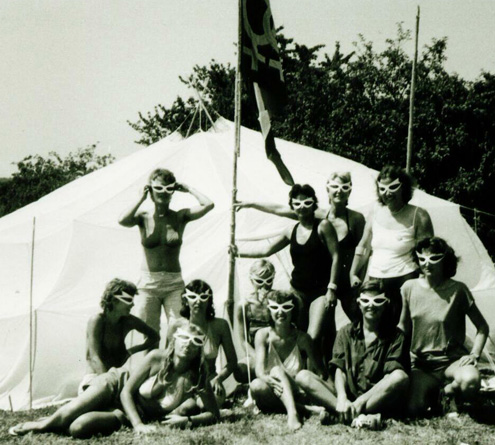
Music applies even to feminist political action: “There’s no business – like show business”!